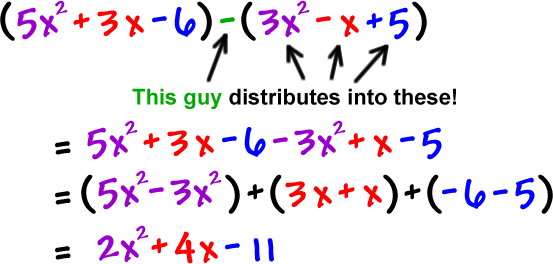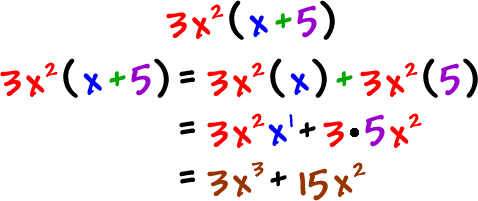~Vocabulary:
In the polynomials unit, we used different types of words that helped us identify an equation. The first one is a degree. A degree is the number of exponents on a variable. To determine the the degree of an equation with multiple potential is by the highest exponent. For example if we have a question like 6x to the 5th power plus 7x to the 3rd power, in this case the
degree is five because five is bigger than three so that’s our degree. A constant is a number on its own without any exponents or variables. For example if we have 4x plus 6 in this case the six is the constant because it doesn’t have any exponents or variables attached to the number. The next one is coefficient. A coefficient is like the constant but its attached with exponents or variables. For example, if we have 7x squared plus 6 the coefficient is seven because its attached to a variable and or exponent and the six is the constant because it doesn’t have any variables or exponents attached to it. Also, if you end up having two coefficients and you don’t know which one is the leading coefficient it’s always the first one in the question.
~How to find how many polynomials are in a equation and what they are called
To find how many polynomials are in an equation, you need to see how many terms there are in an equation. For instance let’s say that we have 2x plus 3. There are two terms in this equation which means we know how many polynomials are in the equation. Now we need to know what they are called. They all have different names based on the terms in the equation. So in this case since there are two terms so its binomial. 
~How do you add polynomials?
If we have a question like (2x squared minus 4x plus 3) + (3x squared plus 6x minus 4), we group up like terms. Once you have grouped up like terms, you should be getting 5x squared plus 2x minus 1. And honestly that’s it! Adding polynomials isn’t very difficult and its straight forward. Adding polynomials may seem easy but it’s one of the most crucial operations out of the four polynomial operations. 
~How do you subtract polynomials?
Subtracting polynomials is the same concept as adding polynomials but there is a difference that can not be missed and if it is, then the whole question becomes wrong. For example, if we have a question like 3x plus 5 minus -8x plus 4 the right side of the question being -8x plus 4 means that we flip the signs to the opposite sign. So in this case, the negative 8x would become positive 8x and the positive four becomes negative four. So now the question is 8x minus 4. The left side of the question being 3x minus 5 stays the same you don’t change that side. It’s important to remember what side you change and what side stays the same. So the answer to the question is 11x minus 9. That’s how you subtract polynomials! It wasn’t that hard it’s just one change from adding polynomials. 
~How do you multiply polynomials?
Multiplying polynomials isn’t like adding or subtracting polynomials it’s actually very different. It uses a law called the distributive property. Let me explain it. For instance, a multiplication equation for polynomials is set up like this. So if we have 2x (3x plus 4), that’s how a multiplication question is set up using brackets. The key thing to remember is that the three and the four isn’t being multiplied by each other but it’s the 2x that is being multiplied by the 3x and the 4. So since we know that there is one more thing we need to keep in mind. There is a variable attached to the two and the three. This means that since we use the multiplication law for exponents which is adding the exponents, it becomes 6x squared. Lastly to finish it off our final answer is 6x squared plus 8x! That’s how you multiply polynomials! 
~How do you divide polynomials?
Dividing polynomials isn’t very complicated if you know the correct process and how to do the question and how to follow the steps. Here is how to divide polynomials! First off we need a question, lets use 6x squared plus 8x minus 2 divided by 2. The first step is to make them into sections so like 6x squared divided by 2, 8x divided by 2 and negative 2 divided by 2. Now all we do is just divide! So we get, 3x squared plus 4x minus 1. And that’s it! Also if you have a variable since you have one x for example its x divided by x but remember there is a coefficient in there so it becomes one. And that’s it! That’s how you divide polynomials! 
~How does this relate to other units?
This relates to one unit very heavily. That unit is exponents. Polynomials is based around constants and coefficients and most of the time, those coefficients will have exponents attached to them. The common exponents attached to these coefficients are x squared or x cubed. Another example is rational numbers. When dividing polynomials, the question is already set up as a fraction and there are constants used and they can be rational numbers. That’s it. That’s what I have learned about Grade 9 polynomials!
~ Sources:
https://www.mathsisfun.com/definitions/constant.html
https://www.pinterest.ca/pin/345440233904378474/
https://virtualnerd.com/pre-algebra/polynomials-nonlinear-functions/add-subtract/add-polynomials/addition-example
https://www.coolmath.com/prealgebra/15-intro-to-polynomials/04-polynomials-adding-subtracting-04-104
https://www.coolmath.com/prealgebra/15-intro-to-polynomials/05-polynomials-multiplying-01-106
https://www.wikihow.com/Divide-Polynomials-Using-Synthetic-Division
